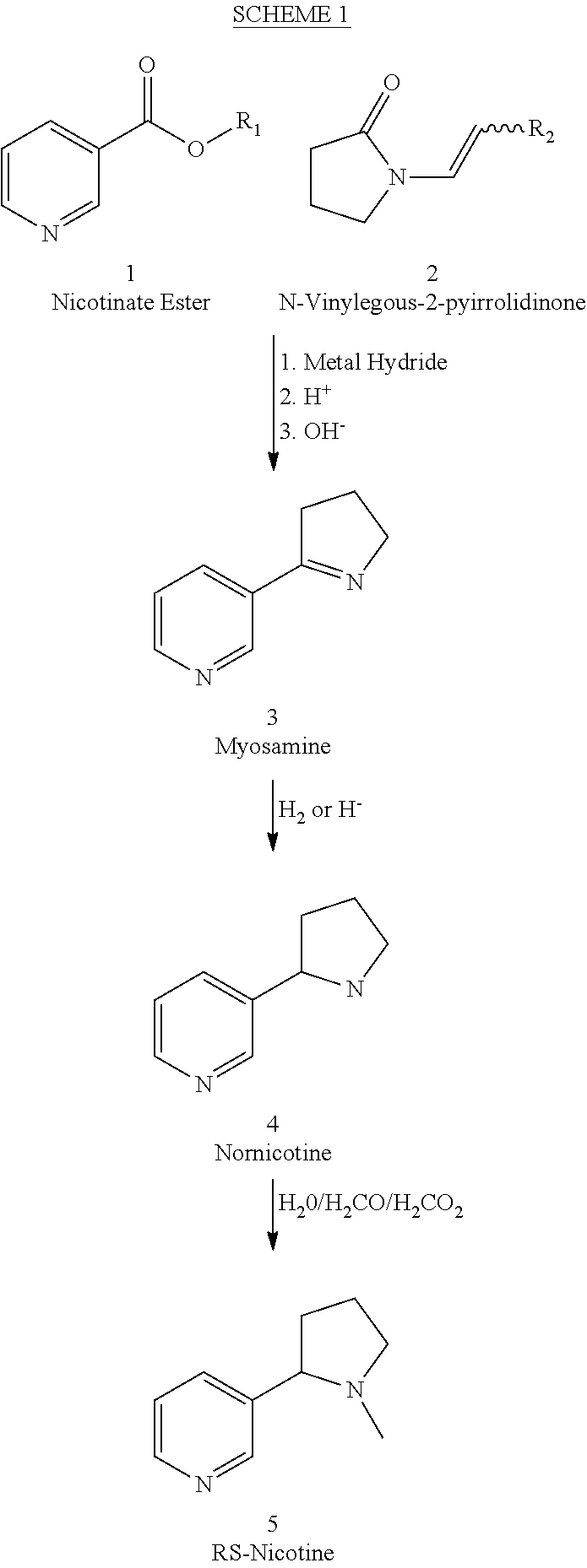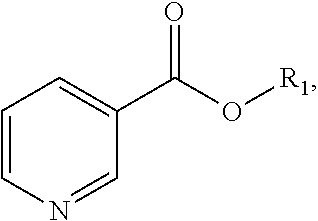Process for the preparation of (R,S)-nicotine
a technology of nicotine and process, applied in the field of synthetic methodology, can solve the problems of prohibitively expensive industrial scale known methods for preparing extremely pure synthetic nicotine, difficult to commercially or even in research quantities, etc., and achieve the effect of reducing myosamine to nornicotin
- Summary
- Abstract
- Description
- Claims
- Application Information
AI Technical Summary
Problems solved by technology
Method used
Image
Examples
example 1
[0033]To a stirred solution of 1-vinyl-2-pyrrolidinone (2) in dry THF under a nitrogen atmosphere was added 1 equivalent of potassium hydride. The reaction was let stir at room temperature for about 20 minutes, then ethyl nicotinate (l equivalent) was added and the resulting mixture stirred 24 hours at 65 degrees centigrade. The reaction was cooled and then acidified with 5% HCl and then concentrated HCl was added and this was then refluxed for 48 hours. The pH was adjusted to 13 with sodium hydroxide, and then 3× equal volume of dichloromethane was added and each time the layers were separated and the combined extracts dried over sodium sulfate, filtered and the solvent evaporated to give amorphous material. This was taken up in 3 parts ethanol was then added, and then palladium on carbon was added (cas 10%) and the resulting mixture was submitted to hydrogen pressure for 6 hours (greater than 25 atmospheres), and then the residue was diluted with more ethanol and filtered through ...
example 2
[0034]To a stirred solution of 1-vinyl-2-pyrrolidinone (2) in dry THF / DMF (3 / 1) under a nitrogen atmosphere was added 1.2 equivalent of sodium hydride. The reaction was let stir at room temperature for about 20 minutes, then ethyl nicotinate (1) (l equivalent) was added and the resulting mixture stirred 24 hours at 65 degrees centigrade. The reaction was cooled and then acidified with 5% HCl and then to this was added concentrated HCl, and the resulting mixture refluxed for 48 hours. The pH was adjusted to 6 and then excess dichlormethane was added and the layers separated. The aqueous layer was extracted twice with excess dichlormethane, and the extracts combined and washed with water, then dried over sodium sulfate. The solution was then filtered and the solvent removed using vacuum to yield a brownish solid. This solid was dissolved in ethanol (ca 5-10 parts) and then 0.5 part palladium on carbon was added and the resulting mixture was submitted to hydrogen pressure for 6 hours (...
example 3
[0035]To a stirred solution of 1-vinyl-2-pyrrolidinone (2) in dry DMF under a nitrogen atmosphere was added 1 equivalent of potassium hydride. The reaction was let stir at room temperature for about 20 minutes, then ethyl nicotinate (l equivalent) was added and the resulting mixture stirred 24 hours at 65 degrees centigrade. The reaction was cooled and then acidified with 5% HCl and then refluxed for 48 hours. The pH was adjusted to 6 and then an isopropanolic suspension of sodium borohydride was added in excess and the reaction let stir 24 hours at room temperature, then acidified to pH about 3 with 5% HCl, then stirred for about 15 minutes. 10 parts dichlormethane was added and the layers separated, the organic layer was dried over sodium sulfate, filtered and then 1.1 equivalent of potassium carbonate was added and then 1.1 equivalent of methyl iodide was added and the reaction let stir 24 hours, filtered and the solvent removed to yield an oil which was vacume distilled to yield...
PUM
| Property | Measurement | Unit |
|---|---|---|
| mole ratio | aaaaa | aaaaa |
| temperature | aaaaa | aaaaa |
| pH | aaaaa | aaaaa |
Abstract
Description
Claims
Application Information
 Login to View More
Login to View More - R&D
- Intellectual Property
- Life Sciences
- Materials
- Tech Scout
- Unparalleled Data Quality
- Higher Quality Content
- 60% Fewer Hallucinations
Browse by: Latest US Patents, China's latest patents, Technical Efficacy Thesaurus, Application Domain, Technology Topic, Popular Technical Reports.
© 2025 PatSnap. All rights reserved.Legal|Privacy policy|Modern Slavery Act Transparency Statement|Sitemap|About US| Contact US: help@patsnap.com


